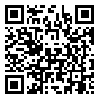Volume 16, Issue 5 (Vol 16, Special Issue 2021)
irje 2021, 16(5): 50-59 |
Back to browse issues page
H Tavakoli Ghouchani1 
 , A Delshad2
, A Delshad2 
 , HR Shoraka3
, HR Shoraka3 
 , H Lashkardoost4
, H Lashkardoost4 
 , A Afshari Safavi5
, A Afshari Safavi5 
 , J Rahimi *
, J Rahimi * 
 6
6

 , A Delshad2
, A Delshad2 
 , HR Shoraka3
, HR Shoraka3 
 , H Lashkardoost4
, H Lashkardoost4 
 , A Afshari Safavi5
, A Afshari Safavi5 
 , J Rahimi *
, J Rahimi * 
 6
6
1- Assistant Professor of Health Education and Promotion, School of Health, North Khorasan University of Medical Sciences, Bojnurd, Iran
2- MD, Deputy of health, North Khorasan University of Medical Sciences, Bojnurd, Iran
3- Research Assistant Professor of Epidemiology, Vector-borne Diseases Research Center, North Khorasan University of Medical Sciences, Bojnurd, Iran
4- Instructor of Epidemiology, Addiction and Behavioral Sciences Research Center, School of Health, North Khorasan University of Medical Sciences, Bojnurd, Iran; Instructor of Epidemiology, Department of Epidemiology and Biostatistics, School of Health, North Khorasan University of Medical Sciences, Bojnurd, Iran
5- Assistant Professor of Biostatistics, Department of Epidemiology and Biostatistics, School of Health, North Khorasan University of Medical Sciences, Bojnurd, Ira
6- Instructor of Epidemiology, Addiction and Behavioral Sciences Research Center, School of Health, North Khorasan University of Medical Sciences, Bojnurd, Iran; Instructor of Epidemiology, Department of Epidemiology and Biostatistics, School of Health, North Khorasan University of Medical Sciences, Bojnurd, Iran ,j_rahimi1992@yahoo.com
2- MD, Deputy of health, North Khorasan University of Medical Sciences, Bojnurd, Iran
3- Research Assistant Professor of Epidemiology, Vector-borne Diseases Research Center, North Khorasan University of Medical Sciences, Bojnurd, Iran
4- Instructor of Epidemiology, Addiction and Behavioral Sciences Research Center, School of Health, North Khorasan University of Medical Sciences, Bojnurd, Iran; Instructor of Epidemiology, Department of Epidemiology and Biostatistics, School of Health, North Khorasan University of Medical Sciences, Bojnurd, Iran
5- Assistant Professor of Biostatistics, Department of Epidemiology and Biostatistics, School of Health, North Khorasan University of Medical Sciences, Bojnurd, Ira
6- Instructor of Epidemiology, Addiction and Behavioral Sciences Research Center, School of Health, North Khorasan University of Medical Sciences, Bojnurd, Iran; Instructor of Epidemiology, Department of Epidemiology and Biostatistics, School of Health, North Khorasan University of Medical Sciences, Bojnurd, Iran ,
Abstract: (1656 Views)
Background and Objectives: The COVID-19 pandemic has led to major health and socioeconomic problems worldwide. This study was conducted to determine the clinical features and health behaviors related to COVID-19 in patients presenting to selected COVID-19 centers of North Khorasan University of Medical Sciences.
Methods: This cross-sectional study was carried out using stratified random sampling in 350 patients presenting to selected COVID-19 centers of North Khorasan University of Medical Sciences in August and September 2020. Demographic and clinical features and the data related to COVID-19 disease were collected using a researcher-made checklist and analyzed with the SPSS 24 software using chi-square test and logistic regression.
Results: Of 350 patients, 200 (57.1%) were male and the rest were female. The PCR test was positive in 72% of the patients. The highest percentage of infection was seen in self-employed subjects and driver, people in the age group 30-50 years, and male subjects. The highest observance of masking, hand washing, and social distancing was related to healthcare staff and the lowest was seen in self-employed people, drivers, and military staff. A history of attending a gas station increased the chance of a positive test by 2.3 times (95% CI: 1.13-4.79).
Conclusion: According to the results, age, gender, occupation and history of presence in crowded places are important determinants of infection and adherence to protocols.
Methods: This cross-sectional study was carried out using stratified random sampling in 350 patients presenting to selected COVID-19 centers of North Khorasan University of Medical Sciences in August and September 2020. Demographic and clinical features and the data related to COVID-19 disease were collected using a researcher-made checklist and analyzed with the SPSS 24 software using chi-square test and logistic regression.
Results: Of 350 patients, 200 (57.1%) were male and the rest were female. The PCR test was positive in 72% of the patients. The highest percentage of infection was seen in self-employed subjects and driver, people in the age group 30-50 years, and male subjects. The highest observance of masking, hand washing, and social distancing was related to healthcare staff and the lowest was seen in self-employed people, drivers, and military staff. A history of attending a gas station increased the chance of a positive test by 2.3 times (95% CI: 1.13-4.79).
Conclusion: According to the results, age, gender, occupation and history of presence in crowded places are important determinants of infection and adherence to protocols.
Type of Study: Research |
Subject:
Epidemiology
Received: 2021/08/8 | Accepted: 2021/03/18 | Published: 2021/03/18
Received: 2021/08/8 | Accepted: 2021/03/18 | Published: 2021/03/18
| Rights and permissions | |
 |
This work is licensed under a Creative Commons Attribution-NonCommercial 4.0 International License. |
